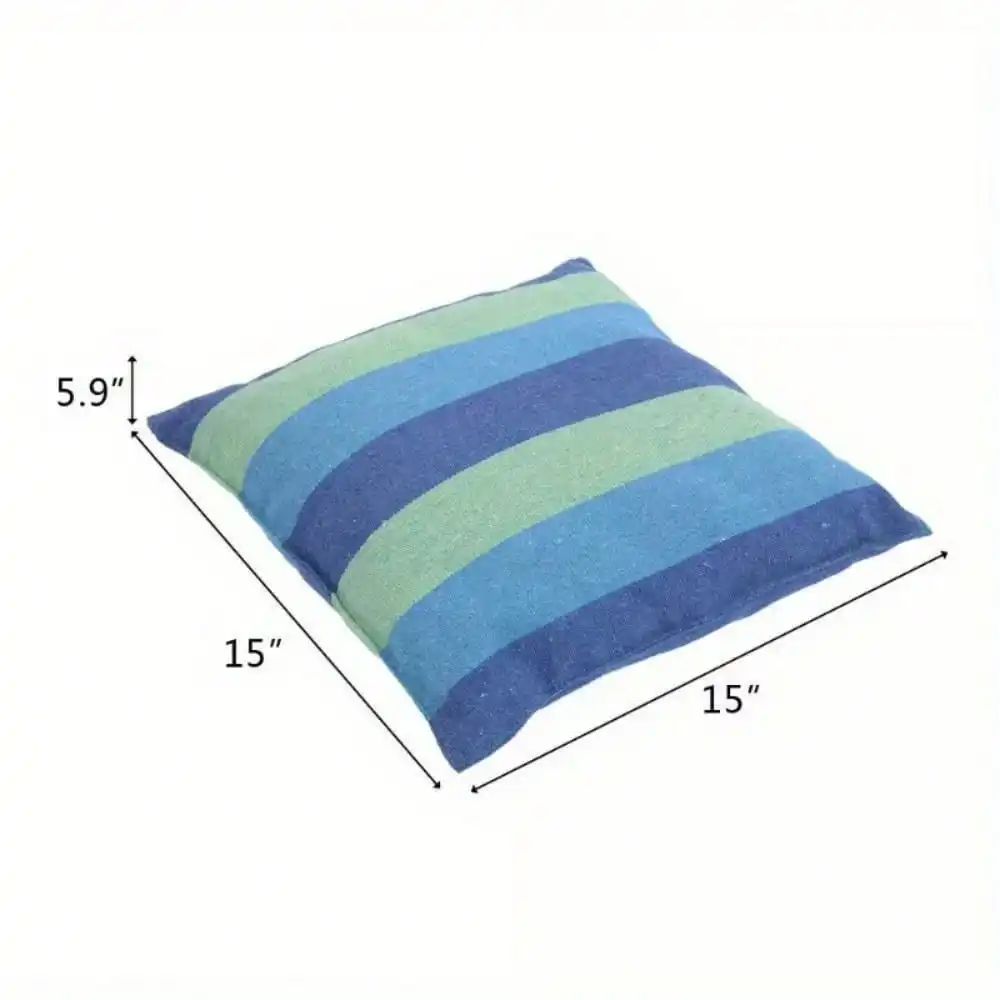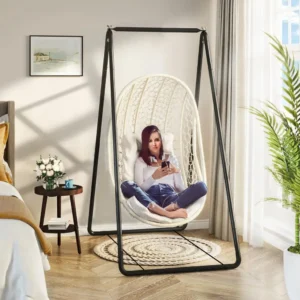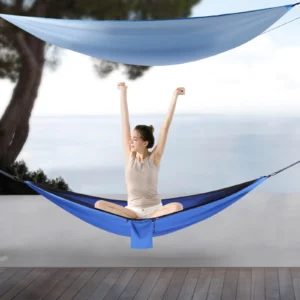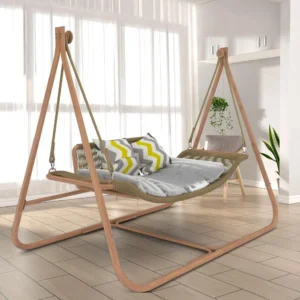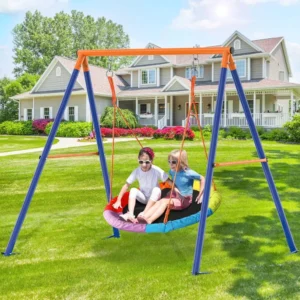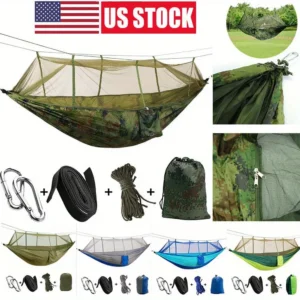Understanding Hammocks as ADHD Support Tools
Attention-Deficit/Hyperactivity Disorder (ADHD) affects approximately 7-8% of children and 2.5-4% of adults worldwide. This neurodevelopmental condition manifests through symptoms like hyperactivity, difficulty maintaining attention, impulsivity, and often includes challenges with sensory processing. These symptoms can significantly impact daily functioning at home, school, work, and social environments.
In recent years, therapeutic tools like hammocks have gained recognition for their potential to help manage ADHD symptoms naturally. While they may seem like simple leisure items, hammocks actually provide specific sensory inputs that can positively affect the nervous system of individuals with ADHD.
The connection lies primarily in vestibular stimulation—the gentle swinging and rocking motion that hammocks naturally provide. This rhythmic movement activates the vestibular system, which plays a crucial role in attention, balance, and emotional regulation. Occupational therapists often incorporate similar swinging motions in therapy sessions to help individuals with sensory processing challenges and attention difficulties.
Understanding proper hammock placement for therapeutic use is essential to maximize these benefits. The height, location, and surrounding environment all contribute to creating an effective sensory tool rather than just a casual relaxation spot.
The Sensory Science: How Hammocks Affect the ADHD Brain
The relationship between hammocks and ADHD symptom management is rooted in neurology. The ADHD brain typically shows differences in neurotransmitter activity, particularly involving dopamine and norepinephrine, which affect attention, mood regulation, and executive function. These differences contribute to the characteristic symptoms of hyperactivity, inattention, and impulsivity.
Hammocks address these neurological aspects through multiple pathways:
Vestibular System Activation
The gentle, rhythmic swinging motion of a hammock directly stimulates the vestibular system, located in the inner ear. This stimulation sends signals throughout the central nervous system, helping to organize and regulate other sensory inputs. For individuals with ADHD who often struggle with sensory integration, this organized input can temporarily improve focus and reduce hyperactivity.
Neurotransmitter Regulation
Research suggests that rhythmic, predictable movement can influence dopamine release in the brain. Since dopamine dysregulation is central to ADHD, the consistent swinging motion may help normalize these levels temporarily, leading to improved attention and decreased restlessness.
Arousal Modulation
The ADHD brain often operates at inappropriate arousal levels—either too high (hyperactive) or too low (inattentive). The combined sensory experience of a hammock helps modulate these arousal levels, bringing them closer to an optimal state for learning and functioning.
Hammocks provide support for both neurological and physical well-being, creating a comprehensive tool for symptom management rather than addressing isolated concerns.
Vestibular Regulation: The Power of Gentle Swinging Motion
The vestibular system is our body’s equipment for detecting movement and position. For many individuals with ADHD, this system may be underactive, leading them to seek extra movement (fidgeting, rocking, spinning) or overactive, causing movement sensitivity and coordination difficulties.
Hammocks offer an ideal solution through their natural swinging motion. When someone sits or lies in a hammock, the gentle, rhythmic oscillation provides consistent vestibular input at a frequency that many ADHD brains find regulating. Unlike aggressive or unpredictable movements, a hammock’s motion typically ranges between 0.5-1.5 Hz (cycles per second)—a frequency range shown to have calming effects on the nervous system.
This vestibular stimulation is particularly beneficial for individuals who display “sensory seeking” behaviors—those who crave movement, often can’t sit still, or frequently seek physical stimulation. The hammock satisfies this need for movement in a controlled, socially acceptable way.
For children and adults with hyperactivity, regular sessions in a hammock can help “feed” the vestibular system’s need for input, potentially reducing the impulse for excessive movement in other situations. This benefit extends beyond the time spent in the hammock, often leading to improved regulation for hours afterward.
Proper hammock installation requirements and safety considerations are crucial to ensure the therapeutic motion is consistent and appropriate, maximizing the vestibular benefits while maintaining safety.
Deep Pressure Touch: The Calming Embrace Effect
Beyond movement, hammocks offer another powerful sensory input: deep pressure touch stimulation. This sensory experience occurs when the hammock fabric wraps around the body, creating gentle, distributed pressure similar to a hug.
Deep pressure touch activates the proprioceptive system—the body’s awareness of position, movement, and force. For individuals with ADHD, this input can be extraordinarily calming, helping to reduce anxiety, hyperarousal, and sensory defensiveness.
The physiological explanation involves the autonomic nervous system. Deep pressure helps shift from the “fight-or-flight” sympathetic state (often overactive in ADHD) to the “rest-and-digest” parasympathetic state. This shift can:
- Lower heart rate and blood pressure
- Reduce stress hormone production
- Increase feelings of security and groundedness
- Improve body awareness and decrease fidgeting
Unlike weighted blankets that provide stationary pressure, hammocks combine this deep pressure with gentle movement, offering a more complete sensory experience. Different hammock materials create varying pressure effects: tightly woven cotton provides firm, consistent pressure, while stretchy fabrics offer a more dynamic, responsive embrace.
The cocoon-like design of swinging hammock chair sets creates an especially effective therapeutic environment, providing the ideal balance of pressure and movement for many individuals with sensory regulation challenges.

Reducing Sensory Overwhelm: Creating a Personal Retreat
Many individuals with ADHD experience sensory overwhelm—becoming flooded and distressed by everyday sights, sounds, and tactile experiences. This sensory sensitivity can trigger anxiety, irritability, and difficulty concentrating, often worsening core ADHD symptoms.
Hammocks address this challenge by creating a defined sensory boundary—a personal retreat from overwhelming environmental stimuli. When enclosed in a hammock:
- Visual input becomes limited and simplified
- The fabric creates a buffer against extraneous noise
- The defined space provides clear tactile boundaries
- Environmental distractions are naturally minimized
This sensory filtering effect makes hammocks particularly valuable during high-stress periods or after sensory-rich experiences like school days, shopping trips, or social gatherings. Many parents report that 15-20 minutes of hammock time after school helps children transition more smoothly into homework or family activities, reducing meltdowns and improving compliance.
The hammock becomes a designated “reset space” where the sensory system can recalibrate without complete withdrawal from the environment. Finding the best indoor and outdoor hammock locations in your space can help maximize this sensory retreat effect, creating zones specifically designed for regulation and recovery.
Focus and Attention: The Concentration Connection
One of the most surprising benefits of hammocks for ADHD management is their potential to improve focus and sustained attention. This seemingly contradictory effect—relaxation improving concentration—stems from the hammock’s ability to provide just enough sensory stimulation to satisfy the ADHD brain’s craving for input.
The gentle motion engages the vestibular and proprioceptive systems, which paradoxically frees up attention resources rather than distracting them. This phenomenon explains why many individuals with ADHD report improved ability to:
- Read for longer periods without distraction
- Listen more attentively to audio content
- Complete thought-intensive tasks without mental wandering
- Engage in creative thinking with fewer blocks
This concentration enhancement works particularly well for activities that can be done while in the hammock, such as reading, listening to podcasts, planning, or brainstorming. The slightly reclined position combined with gentle movement creates an optimal state for focus without the restlessness that often accompanies seated activities at desks or tables.
Many families and educators have successfully incorporated hammock time into homework routines, finding that complex or challenging assignments become more manageable when done during or after hammock sessions. Deep seat chair hammock sets provide excellent support for these focus-oriented activities, combining comfort with the appropriate level of sensory input.
Types of Therapeutic Hammocks for ADHD Management
Not all hammocks provide the same therapeutic benefits for ADHD. Specific design features can enhance or diminish their effectiveness as sensory tools:
Sensory Hammocks
- Designed specifically with therapeutic benefits in mind
- Often feature stretchy, spandex-blend fabrics that provide dynamic pressure
- Create deeper enclosure for enhanced sensory boundaries
- Support various positions including sitting, reclining, and fully lying down
- Best for individuals seeking significant vestibular and proprioceptive input
Therapy Swings and Cocoon Hammocks
- More enclosed design with minimal or no openings
- Create a complete sensory environment with maximum boundary definition
- Often made from lycra or similar stretchy materials
- Provide the highest level of deep pressure stimulation
- Ideal for sensory retreats during overwhelm or anxiety
Traditional Hammocks with Therapeutic Features
- Woven designs with varying degrees of fabric stretch
- Provide moderate vestibular input with gentle swaying
- Often more aesthetically pleasing for home environments
- Balance between therapeutic benefit and practical functionality
- Better for longer rest periods and activities requiring more space
When selecting a therapeutic hammock, consider:
– Material stretch (more stretch = more dynamic sensory input)
– Weight capacity (must safely support the user’s full weight during movement)
– Depth of the seating pocket (deeper = more enclosure and security)
– Ease of entry/exit (particularly important for younger users)
– Indoor vs. outdoor durability (based on intended placement)
Versatile hammock chair options often provide an excellent starting point for therapeutic use, offering a good balance of sensory benefits in a manageable size for most homes.

Indoor vs. Outdoor Hammocks: Which Works Best for ADHD?
Both indoor and outdoor hammocks can provide therapeutic benefits for ADHD, but each environment offers distinct advantages and challenges:
| Feature | Indoor Hammocks | Outdoor Hammocks |
|---|---|---|
| Access | Year-round, regardless of weather | Seasonal or weather-dependent |
| Sensory environment | Controlled lighting and sound | Natural stimuli (breeze, sounds) |
| Movement quality | Typically more stable, consistent motion | May have more variable motion from wind |
| Space requirements | Need dedicated interior space | Require suitable outdoor structures/trees |
| Supervision ease | Easier to monitor while doing other activities | May require more dedicated supervision |
| Integration into routines | Easily incorporated into daily activities | May be seen as special occasion use |
Indoor hammocks provide consistency and accessibility, making them ideal for regular therapeutic use and established sensory routines. They can be easily integrated into bedrooms, playrooms, or quiet corners, allowing for spontaneous use when symptoms arise.
Outdoor hammocks offer the additional benefit of nature exposure, which itself can help reduce ADHD symptoms. The combination of natural settings with hammock therapy can be particularly powerful, though less consistently available in many climates.
For maximum therapeutic benefit, many families choose to have both options available, using indoor hammocks for daily regulation and outdoor versions for deeper sensory experiences when weather permits. Understanding safety considerations for indoor hammock use is particularly important when setting up these therapeutic spaces.
Setting Up a Therapeutic Hammock Space
Creating an effective hammock space for ADHD management requires thoughtful planning beyond simply hanging the hammock:
Location Considerations
- Choose a semi-private area with minimal distractions
- Ensure adequate clearance for swinging motion (at least 3 feet on all sides)
- Select an area away from fragile items or furniture with sharp corners
- Consider proximity to quiet activities for transitions after hammock time
Technical Setup
- Install at appropriate height (18-24 inches from floor when weighted)
- Ensure anchor points can support at least 350 pounds (regardless of user weight)
- Test stability before full therapeutic use
- Position to allow easy entry/exit without awkward movements
Environmental Elements
- Maintain moderate lighting—natural light is ideal, but avoid harsh direct sunlight
- Consider sound environment—some benefit from quiet, others from gentle music
- Have comfort items nearby (pillows, blankets, fidgets for hands)
- Create visual boundaries if in a shared space (room dividers, curtains)
Safety Features
- Place soft surfaces beneath the hammock
- Keep emergency access clear
- Install according to manufacturer specifications
- Regularly inspect hardware and fabric for wear
Creating optimal therapeutic environments involves balancing accessibility with sensory control, ensuring the hammock becomes a reliable tool rather than an occasional novelty.
Practical Implementation: Daily Hammock Routines for ADHD Management
Integrating hammock time strategically throughout the day can maximize its therapeutic benefits for ADHD management:
Morning Energizing Routine (5-10 minutes)
- Vigorous swinging to wake up the vestibular system
- Can help “jump-start” attention for the day
- Pair with reviewing daily schedule or goals
- Helps transition from sleep inertia to alert state
After-School/Work Reset (15-20 minutes)
- Gentle rocking with deep pressure
- Creates clear boundary between structured time and home life
- Allows processing of the day’s sensory and social inputs
- Reduces transition meltdowns and irritability
Homework Support Session (Varies by task)
- Read in hammock for 20-30 minutes
- Take hammock breaks between subjects (5-10 minutes)
- Use for brainstorming or planning stages of projects
- Alternative seating for appropriate assignments
Pre-Bedtime Calming (15-20 minutes)
- Very slow, gentle rocking
- Dim lighting and quiet environment
- Possible transition to sleep location for younger children
- Helps downregulate after evening activities
The key to effective implementation is consistency—making hammock time a regular, expected part of the routine rather than just a crisis intervention. Portable hammocks with sturdy stands offer flexibility to create these routines in various spaces, adapting to changing needs and environments.
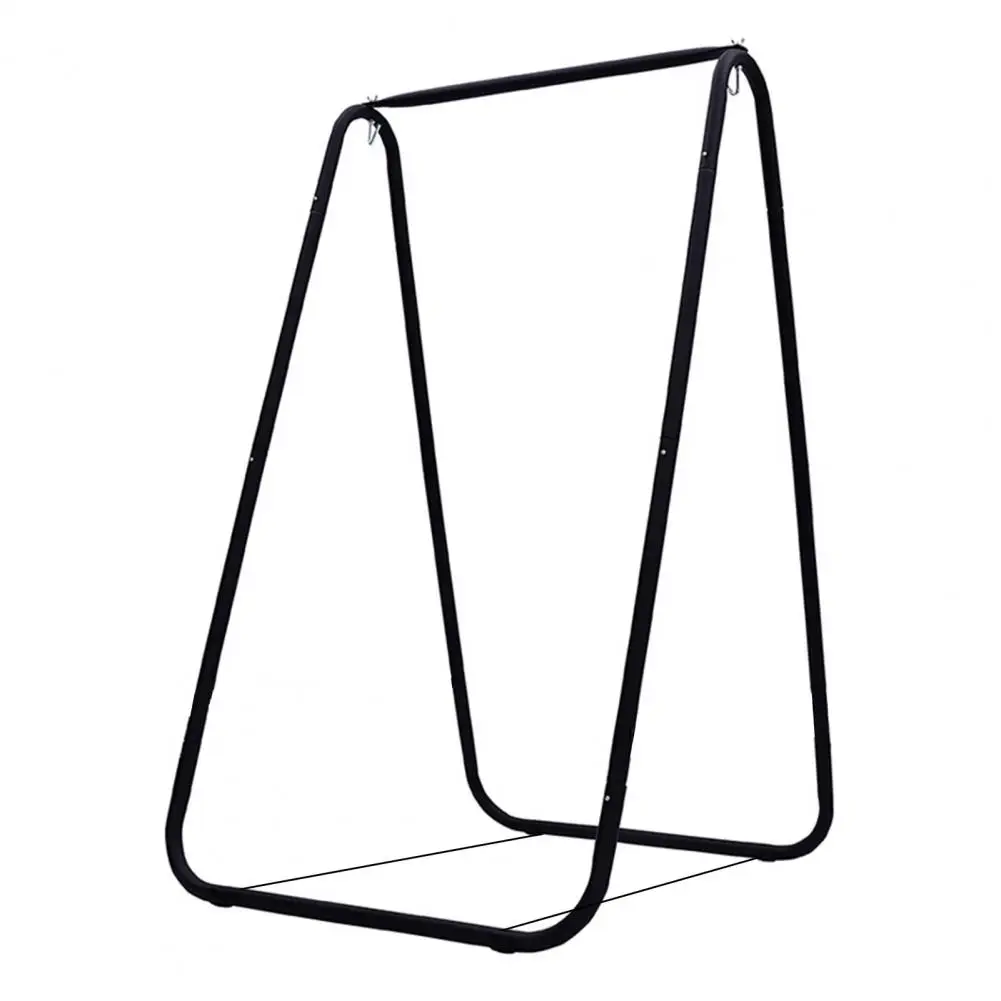
Can Hammocks Replace Other ADHD Interventions?
Hammocks should be viewed as valuable complementary tools rather than replacements for comprehensive ADHD treatment approaches. Their most effective role is as part of a multi-faceted management strategy that might include:
- Medical interventions (where appropriate)
- Behavioral strategies and skill development
- Educational accommodations
- Nutritional considerations
- Physical activity
- Sleep hygiene practices
- Other sensory tools and supports
The benefits of hammocks specifically target sensory regulation and environmental modification aspects of ADHD management. They work particularly well alongside other interventions by:
- Creating consistent sensory input that can enhance medication effectiveness
- Providing regulated breaks that improve stamina for behavioral approaches
- Offering alternative seating for learning activities
- Supporting emotional regulation needed for social skill development
For best results, consult with healthcare providers—particularly occupational therapists familiar with sensory integration approaches—about how to integrate hammock time with other treatments. Creating a comprehensive hammock haven as part of a broader support strategy yields better outcomes than relying on any single intervention.
Dark Wood Hammock Sets, Porch Swing Chair Sets
$653.82 Select options This product has multiple variants. The options may be chosen on the product pageA-Frame Stand Hammock Sets, Swinging Hammock Chair Sets
$154.62 Select options This product has multiple variants. The options may be chosen on the product pageCamping Hammock Sets with Bug Net, Ultralight Camping Hammock Sets
$139.72 Select options This product has multiple variants. The options may be chosen on the product pageLight Wood Hammock Sets, Swinging Hammock Chair Sets
$1,359.35 Select options This product has multiple variants. The options may be chosen on the product pageFolding Hammock Sets, Quick Setup Hammock Sets
Price range: $305.52 through $583.27 Select options This product has multiple variants. The options may be chosen on the product pageCamping Hammock Sets with Bug Net, Complete Camping Hammock Systems
Price range: $82.73 through $97.96 Select options This product has multiple variants. The options may be chosen on the product page
Are There Any Risks or Drawbacks to Consider?
While hammocks offer significant benefits for ADHD management, responsible implementation requires awareness of potential limitations:
• Safety Considerations
– Proper installation is crucial to prevent falls
– Weight limits must be strictly observed
– Supervision requirements vary by age and physical ability
– Entanglement risks exist, particularly with rope hammocks
• Implementation Challenges
– Require adequate space that many homes may lack
– Quality therapeutic options may represent significant investment
– May face resistance from schools or other settings
– Require consistent maintenance and inspection
• Individual Variations
– Not all individuals with ADHD respond the same way to vestibular input
– Some may experience overstimulation rather than regulation
– Benefits may be temporary rather than cumulative for some users
– May become less effective if novelty wears off
• Practical Limitations
– Weather dependency for outdoor options
– Installation limitations in rental properties
– May create dependence if not paired with skill development
– Not always portable for travel or school settings
Understanding comprehensive safety guidelines for therapeutic hammock use helps minimize these risks while maximizing potential benefits.
Frequently Asked Questions About Hammocks for ADHD
How long should someone with ADHD use a hammock to see benefits?
Most individuals notice immediate effects during and shortly after hammock use. For regulation benefits, sessions of 15-20 minutes are typically effective. Consistent daily use tends to produce more stable results than occasional use.
What age is appropriate to start hammock therapy for ADHD?
With proper supervision and appropriate equipment, children as young as 3 years can benefit from therapeutic hammock use. Features like enclosed hammocks with bug nets can provide additional security for younger users while maintaining sensory benefits.
Can hammocks help with ADHD-related sleep problems?
Many users report improved sleep quality when using hammocks for pre-bedtime regulation. The vestibular input and deep pressure can help calm the nervous system, potentially easing the transition to sleep. However, sleeping overnight in hammocks requires specific designs for proper spinal alignment.
Which type of hammock movement is best for ADHD?
The ideal movement varies by individual needs. Side-to-side swinging typically provides more intensive vestibular input beneficial for attention, while gentle rocking tends to be more calming for hyperactivity and emotional regulation.
How do I know if a hammock is helping with ADHD symptoms?
Look for observable changes in regulation: decreased fidgeting, improved transition between activities, extended attention span, reduced emotional reactivity, or more organized behavior following hammock sessions. Keeping a simple log can help identify patterns.
Can adults with ADHD benefit from hammocks too?
Absolutely. The sensory regulation benefits apply across the lifespan, though adults may prefer more discreet options like hammock chairs that integrate better into typical home decor while still providing therapeutic benefits.
Do hammocks help with all types of ADHD?
Hammocks tend to be most beneficial for individuals with hyperactive and combined presentations of ADHD, particularly those with sensory processing challenges. Those with primarily inattentive ADHD may still benefit but might require different usage patterns focusing more on focus support than calming.

